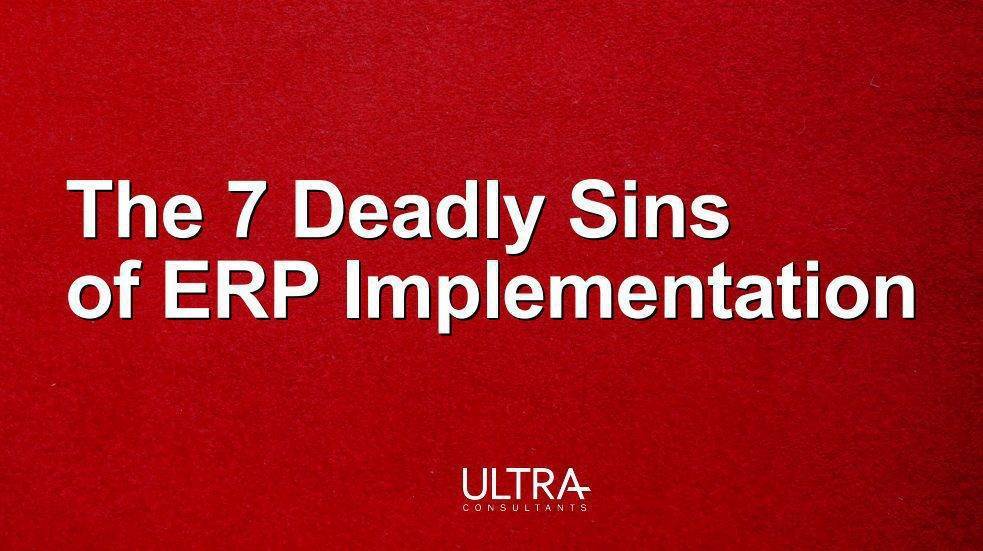As a member of Ultra’s team of independent ERP consultants guiding manufacturers and distributors, I often work with engineering-intensive companies seeking the capabilities of product lifecycle management software (PLM). These organizations seek to improve the productivity of engineering resources and reduce the time to develop new products.
In many engagements over the years, we see manufacturing organizations faced with increasing demands to deliver the right product, with zero defects, on time and in budget.
Meeting these requirements often means reducing the duration of design and product engineering cycles.
In the effort to maintain “a single source of the truth,” a typical challenge is the effective integration of PLM and ERP to enable seamless delivery of products from design conception to manufacturing and distribution.
In upcoming blog posts, I’ll be delving into the business issues surrounding PLM selection, evaluation and integration with ERP.
To kick off the series, offered below are typical questions about PLM and ERP we hear when working with manufacturing and distribution teams out in the field.

Top Questions about PLM and ERP
1 – What are common issues for manufacturing organizations in terms of managing the PLM process?
Some of the most common issues facing manufacturers include delays, mistakes, and inefficiencies associated with the manual management of Item Master data across the enterprise.
Many of the organizations we work with have been using spreadsheets, network folders, and other stand-alone solutions to track product data. This increases an organization’s chance of making mistakes, as well as incurring delays and expenses, during the product development process.
In many companies, it is difficult to control versions, and trust the integrity of the item master data when they are manually managing Item CAD files, Engineering Changes, and Bills of Material (BOMs).
At Ultra, we help our clients drive business process improvements, across engineering, Quality, and manufacturing activities. We help our clients move from a low capability process of manual product Item data management to implementing PLM as a common toolset for managing and communicating product data across your organization.
2 – What are the drivers that would compel a team to look for a new PLM system?
Significant project drivers include the need to reduce the cost and cycle times of product development, which is critical given today’s advances in complex, connected products.
Another key driver is the need to reduce mistakes, such as those caused by using outdated manual methods, spreadsheets, siloed product data management, and other stand-alone processes.
Organizations look to improve and streamline the configuration and control of product data throughout all stages of development, from initial concept, through to design and production.
By streamlining the process using modern PLM, a company avoids the issues of overwritten or lost item-related data and potential rework of engineering design efforts or mistakes on the manufacturing floor.
3 – Do manufacturers typically need both PLM and ERP?
It’s our guidance that manufacturers need both PLM and ERP systems
At its core, ERP is an organization’s financial system offering, accounting, GL, purchasing, A/R & A/P, order management, and inventory accounting.
In contrast, PLM has unique features that manage item design, engineering simulation data and EBOMs. A PLM system also tracks material sources, compliance, quality, and all engineering documents. PLM manages items and parts before they received final approval for production. No organization should want to clutter up their ERP financial system with thousands of items which may not eventually be produced or purchased.
In a typical business process review, we see that seamless integration between PLM and ERP is a must. Many companies grapple with their processes when PLM and ERP are not fully integrated. These companies risk mismanaging product changes and therefore creating mistakes in manufacturing or failing to correct product quality issues. Without PLM – ERP integration, there is duplicate data entry of approved items and the Item information in the ERP system is missing valuable information from Engineering.
Learn More about PLM and ERP
Current complex and accelerated product development cycles demand that today’s enterprise undergoes true business process transformation.
In upcoming blog posts, watch for additional insights related to the business issues surrounding PLM selection, PLM evaluation, and integration with ERP and other enterprise systems.
As your organization seeks to streamline processes, contact the Ultra team to find out how true integration between PLM and ERP enables seamless delivery of products from design conception, through to manufacturing and distribution.
About the Author:
 David Buck is a Senior Consultant for Ultra and has more than thirty years of experience managing the technical delivery of Information Technology projects. He offers expertise in solutions architecture, program management, project management, enterprise architecture, methodologies, software package selection, integration, implementation, and software development.
David Buck is a Senior Consultant for Ultra and has more than thirty years of experience managing the technical delivery of Information Technology projects. He offers expertise in solutions architecture, program management, project management, enterprise architecture, methodologies, software package selection, integration, implementation, and software development.
The 7 Deadly Sins of ERP Implementation
Some mistakes are just bad strategic or financial decisions. Some are the inevitable consequence of situational or organizational factors. Some, however, are the result of process-oriented or people-centric choices – and are easily avoided. These are The Seven Deadly Sins of ERP Implementation.
Table of Contents
More ERP material...
Assessing Your AI Maturity
This article breaks down how businesses can measure their AI maturity to…
Why You Should Hire a Business Process Improvement Expert to Kick Off Your AI Business Transformation
AI won’t fix broken processes; it’ll just make the chaos run faster.…
How Food Manufacturers Can Use Existing ERP to Optimize Supply Chains
Food manufacturers often underuse their ERP systems, missing opportunities to strengthen supply…




